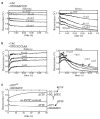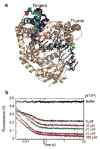Techniques used to study the DNA polymerase reaction pathway
- PMID: 19665596
- PMCID: PMC2846202
- DOI: 10.1016/j.bbapap.2009.07.021
Techniques used to study the DNA polymerase reaction pathway
Abstract
A minimal reaction pathway for DNA polymerases was established over 20years ago using chemical-quench methods. Since that time there has been considerable interest in noncovalent steps in the reaction pathway, conformational changes involving the polymerase or its DNA substrate that may play a role in substrate specificity. Fluorescence-based assays have been devised in order to study these conformational transitions and the results obtained have added new detail to the reaction pathway.
Copyright (c) 2010 Elsevier B.V. All rights reserved.
Figures









References
-
- Johnson KA. Transient-state kinetic analysis of enzyme reaction pathways. In: Boyer PD, editor. The Enzymes. Academic Press; New York: 1992. pp. 1–61.
-
- Fersht A. Enzyme structure and mechanism. 2. W. H. Freeman; New York: 1985.
Publication types
MeSH terms
Substances
Grants and funding
LinkOut - more resources
Full Text Sources
Other Literature Sources

